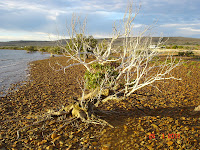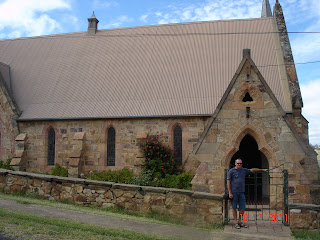Fitzgerald Bay – Whyalla – Port Gibbon
Tuesday, Jan. 25th
Our 1st stop was the Whyalla Maritime Museum and it was a great way to start the day. The $10 entry was great value as the museum is home to the ‘Whyalla’, the 1st ship to be built in the shipyards in the ‘40s. After touring the museum we had a guided tour of this corvette/minesweeper which saw service from 1941 to 1946, then was sold to Victoria where one of her jobs was in the blasting of the Port Phillip heads.
 |
| The Whyalla Maritime Museum |
 |
| The smelter |
Whyalla is a town something like Gladstone but on a smaller industrial scale. The buildings, paved areas, roofs etc are all red and the smelter generates lots of red dust so this fits in well. Wide streets, incredibly clean, as are most SA towns it seems (no plastic bags offered in shops and bottle deposits paid) but not much here. A quick swim at the foreshore and a solar-heated shower to rinse off, then off to Hummock Hill to look down over the town and the water.
From Whyalla we drove past Iron Knob, the flattened hill from which the ore has been extracted for many years and is still being mined, to Cowell, the home of the oyster farms – although a number of Eyre Peninsula towns claim this as their title. Cowell is another of the fishing towns along the gulf, with a long jetty, a big pub and not much else. Graeme had a quick lesson in oyster shucking and we bought a dozen unopened oysters for my dinner, some sourdough bread and a bottle of wine!
We then drove on to Port Gibbon, our free camping site for the evening. It was a ‘first’ in many ways – the locals had taken ownership of this site and had set up rules and regulations about the way the vehicles should be parked on their bit of red dirt, some areas were roped off, there were drop toilets with signed stones along the shelves, sea urchins threaded on string and an amazing assortment of bits and pieces. The area looked a bit like a dump, with an assortment of vehicles, including an ancient blue bus, campsites with clothing spread around, people sleeping in cars etc. Definitely not a room with a view! However, the sea was just a quick walk down some steps and the locals indicated that the fishing was good, so we settled in for the night although the wind was too strong for us to put up the awning.
 |
| Oysters at last! |
We then drove on to Port Gibbon, our free camping site for the evening. It was a ‘first’ in many ways – the locals had taken ownership of this site and had set up rules and regulations about the way the vehicles should be parked on their bit of red dirt, some areas were roped off, there were drop toilets with signed stones along the shelves, sea urchins threaded on string and an amazing assortment of bits and pieces. The area looked a bit like a dump, with an assortment of vehicles, including an ancient blue bus, campsites with clothing spread around, people sleeping in cars etc. Definitely not a room with a view! However, the sea was just a quick walk down some steps and the locals indicated that the fishing was good, so we settled in for the night although the wind was too strong for us to put up the awning.
Port Gibbon – Colwell – Point Gibbon
Wed. Jan 26th
The national flags were flying as we headed off to Colwell to try our luck with crabbing – we bought a net in Whyalla so that we could take part in this SA summer ritual. We’re almost able to accept that the wind will be with us wherever we travel along these SA coasts. The bikers were in town and their gleaming Harleys and others were parked along the front of the pub. Others were spending Australia Day playing cricket in the park on the foreshore.
Graeme baited the crab net with a whole mullet and we launched the net, then he set up his fishing rod and I walked along the short mangrove boardwalk while he waited. Alas, one small crab and no mullet. Something big and strong had managed to remove the whole fish. This set up a challenge for GVS as he is determined to find a way of securing the 2nd mullet to the net so that even a tsunami could not remove the fish! We’ll see when we next try our luck.
We returned towards Port Gibbon but decided to take the track up to Point Gibbon – what a difference a name makes! This was a magnificent spot, with white sand hills, red cliffs nearby, a beautiful sandy beach and a delight to the eye. Imagine seeing 3 sunbaking sea lions around the point! These huge creatures were lying on the beach and moved occasionally as the tide came in and wet their tails.
There were many people driving their 4wds of the beach, over the dunes etc. so we settled in for some fishing, walking, reading etc. and we spent the night perched up on the top of the beach. Graeme was most put out when I prepared dinner so I won’t do that again!
There were many people driving their 4wds of the beach, over the dunes etc. so we settled in for some fishing, walking, reading etc. and we spent the night perched up on the top of the beach. Graeme was most put out when I prepared dinner so I won’t do that again!
The sunset was superb and I sat in the dunes and watched the sky become a vibrant pink. When darkness fell, more cars came along from up the beach and one group set up a fireworks display on top of the highest sand dune and I had a ringside seat. Beautiful!
Point Gibbon
Thurs. Jan. 27th
A lovely sunrise over the water was a great start to the day. Walking over the sand dunes, tracking prints in the sand and wondering what creatures had come out in the night to feed.
Great to have a call from Chris T and catch up on her news. Called Sal and was relieved to hear that Ben has flash burns and while they are very painful, he will make a full recovery.
After a morning spent fishing, walking and enjoying being the only people on the beach, we headed south towards Arno Bay, another scenic holiday and fishing town of small proportions. Graeme fished on the jetty and I walked along the excellent, award-winning mangrove boardwalk. Fishing bays set up with rod holders and cleaning benches encouraged fishermen to try their luck in the tidal creek. We could see quite large mullet swimming in the shallow water. Some time was spent in conversation with a man who had some very interesting conspiracy theories, wouldn’t allow his children to be vaccinated as that was the way in which the government controlled the population and digital TV was a way of sending thought controlling sound waves. The fascinating thing was the way in which he made it all sound plausible!
On to Tumby Bay, a much larger holiday town with a pretty, Norfolk Island pine plantation along the foreshore, a long pier and a caravan park right on the beach. A fisherman cleaning fish had a hoard of silver gulls and 3 large pelicans waiting for the left-overs! Hot showers, 3 loads of laundry and all was well with the world.
Heard from Maz that last Sunday Ben had been injured by an exploding aerosol can at a BBQ, airlifted to the Alfred but now home and while not well, he would be fine later.
Tumby Bay to Louth – about 30km!
Friday, Jan 28th
Great to have a call from Chris T and catch up on her news. Called Sal and was relieved to hear that Ben has flash burns and while they are very painful, he will make a full recovery.
We walked on the jetty, visited the Op Shop to look for books (none) then headed towards Port Lincoln. We only made it 30km down the road to a lovely quiet holiday spot called Louth Bay where we found mainly holiday homes, relatively new but simple, no cars and few people. We pulled into the Council camping spot – toilet and running water – and discovered a few people from previous spots. We’ve been on this part of the road for long enough now to recognise each other. Many of them have been on the road for years. We hopped on the bikes and explored the various beaches and rocky outcrops. A beautiful fish had been trapped in a pool by the outgoing tide so we have decided to snorkel here tomorrow on an outgoing tide. We love the SA coastline along this side of the Eyre Peninsula.


I wanted to buy smoked salmon pieces from a local, so we went into his home and ended up having a tour of his incredible shell and fossil collection. He was a natural raconteur, telling tales about the acquisition of various items and trying to sell us some jewellery. We enjoyed having the time to listen to him but ended up only with smoked salmon and some cockles for bait.
As the weather forecast is for a hot weekend, we plan to stay a few days and enjoy this pretty place.
Louth
Sat. Jan. 29th
We took an early walk around the estuary and along the beach. Once again, warm, sunny day, warm water and a cooling breeze. Tried fishing and swimming around at one of the rocky areas. Swimming was greatJ
Watched the Clijsters/Li women’s singles final and really enjoyed the 1st 2 sets – great, hard-hitting and skilful tennis.
Sun. Jan 30th
Up at 6 to pull down the awning as a wild northerly was blowing. Although we were reasonably sheltered from the wind, the awning was flapping, so ‘take no chances’ is the rule. I walked on the beach and swam in the crystal clear water. It was still not 10am when we went snorkelling around in another bay where there were plenty of rock pools, an outgoing tide and not much wind over the water: lovely pink, white and orange seagrasses, thick kelp and many 15cm angelfish in and around the reef. We saw some larger striped fish and some tiny purple ones too. Must look these up!
Graeme rigged up a shower from the tap in the toilet facilities so we both enjoyed washing off the salt and rinsing bathers ready for the afternoon swim.
Our neighbours have their generators on and haven’t been sighted, so we assume that they are sitting in air-conditioned comfort! These seasoned travellers like their creature comforts.
2 exhausted young backpackers from Geelong came into the camp in the afternoon – they sat outside Whyalla for 4 hours trying to hitch a lift and were suffering the effects of the heat and dehydration. Lachlan and Francis were heading to Perth via any route they could find. Graeme cooked dinner for them and they were most grateful. They told some entertaining stories about their journey to date, including the footy-melon man and his hybrid melons and the racism of younger locals past Pt Augusta. They had some very kind people look after them on the way and an ABC journalist from Pt Lincoln was coming to Louth to pick them up and interview them for a story.






































